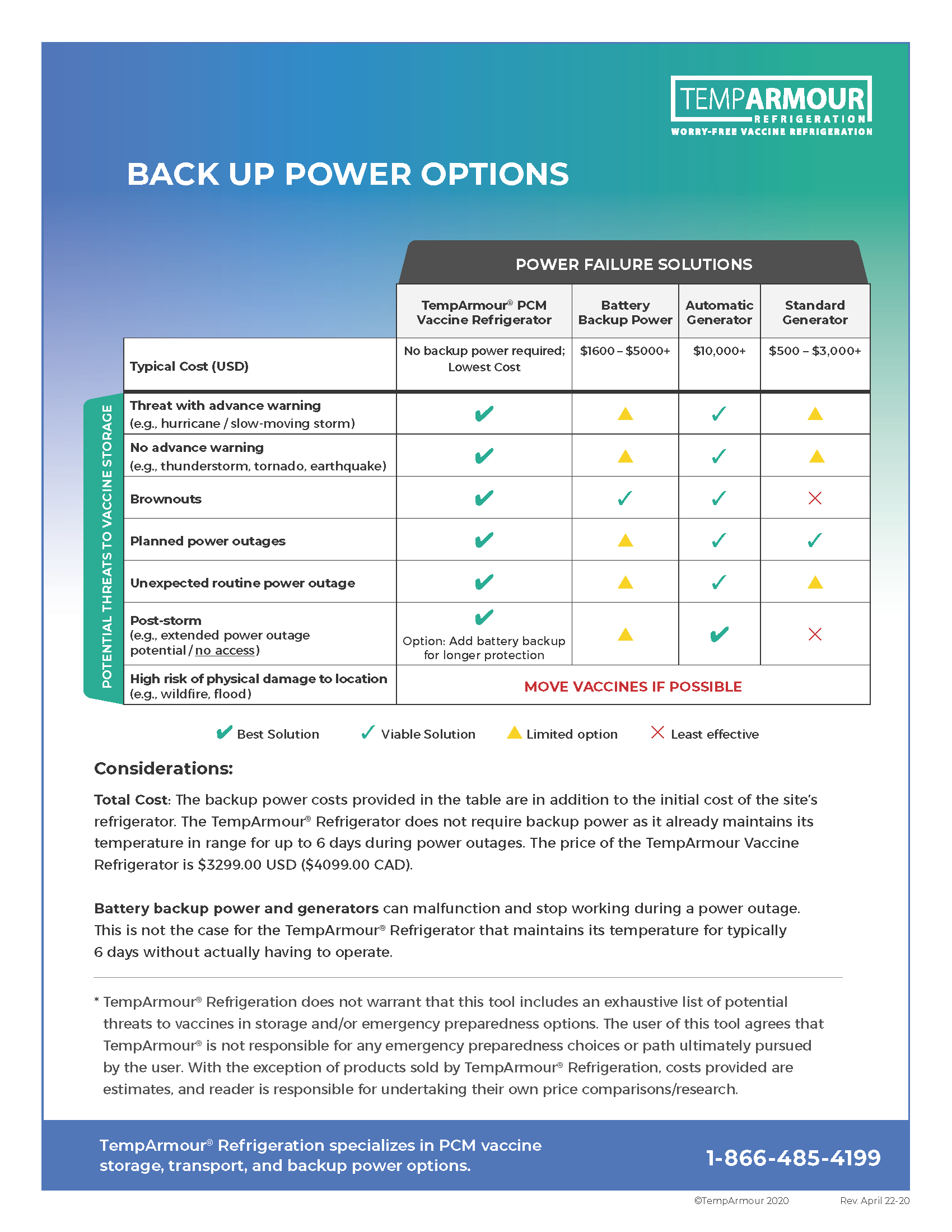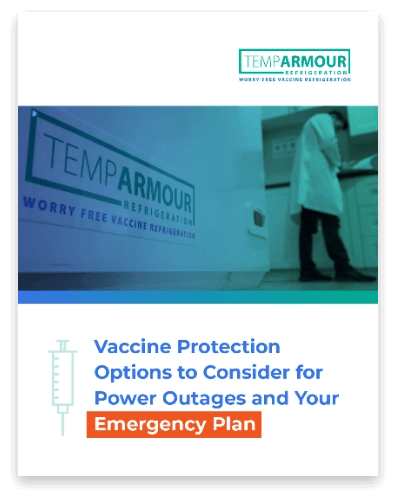
How safe are your vaccines during a power outage? Unfortunately, even if you have a medical grade refrigerator and freezer, it might not keep your vaccines in the proper temperature range throughout an emergency.
And it pays to be prepared. When the lights go out, you may only have a few hours before your vaccines are compromised.
Backup power is a common way to keep refrigerators and freezers running and your vaccines secure. Here are the ins and outs of backup power for maintaining the temperature of your vaccines and temperature-sensitive medicines:
How Can Vaccines Be Affected During Power Outages?
Vaccines are sensitive biological substances that are extremely vulnerable to the power outages that often accompany emergency situations. Here’s why refrigerated and frozen vaccines need to be stored in their required temperature ranges:
- Vaccines are sensitive to temperature spikes and dips
- Refrigerated vaccines are no longer viable if frozen
- Refrigerated and frozen vaccines lose potency, and may have to be disposed of if they get too warm (dependent on many factors, including type of vaccine and length and severity of temperature excursion)
The correct storage temperature range for refrigerated vaccines is:
2-8ºC (36-46ºF)
The correct storage temperature range for frozen vaccines is:
-50ºC to -15ºC (-58ºF to +5ºF)
When the power goes out, the temperature in some fridges will rise quickly. And that puts your vaccines in danger. Follow manufacturers' guidance with respect to the temperature storage requirements of refrigerated vaccines and medicines.
What’s the cost of compromised vaccines? In addition to having to replace expensive medicine, an outage that results in a temperature excursion can be disruptive to an office due to increased administration and coordination related to: reporting of the excursion, replacement of the vaccines, rescheduling of immunization appointments, and so on.
How Long Do Vaccine Refrigerators Stay Cold During a Power Outage?
If you’re not using an advanced medical grade refrigerator, there’s a good chance you’ll only have a few hours before vaccines are endangered. Remember, refrigerated vaccines need to stay between 2°C and 8°C. According to the American Academy of Pediatrics, most refrigerators will be warmer than 8°C within three hours of an outage.
Still, there are medical grade refrigerators that are built to withstand power outages for several days. Overall, the length of time for which your vaccines will be protected without backup power largely depends on the model and type of refrigerator where you’re storing them. Other factors including room temperature, how full the fridge is, or if water bottles have been added for stability, will affect how long the temperature will stay in range.
Do Medical Grade Refrigerators and Freezers Need Backup Power?
If you’ve invested in a medical grade refrigerator and freezer, you may wonder if you need to worry about backup power. The answer? It depends.
First, it depends on how well your refrigerator is able to stay cool without electricity. Remember, your vaccines don’t just need to stay relatively cold. They should stay within a consistent temperature range between 2°C and 8°C (36º-46ºF).
Second, it depends on the unique circumstances and how long you anticipate the outage will last. Some fridges will maintain their temperatures without power for hours or days longer than others will.
The TempArmour chest refrigerator with phase change material (PCM) technology can stay in temperature range without power for up to six days. This means that if you use this advanced type of medical grade fridge, you don’t necessarily have to worry about backup power.
With this exception in mind, not all medical grade refrigerators and freezers have these capabilities. That’s why you should start by finding out how long your refrigerator can keep temperature consistent without power and how many hours you need as part of your emergency plan to protect your vaccines during power outages. From there, you can decide what kind of backup power is the best fit.
Luckily, there are a number of options to help keep vaccines secure through power outages. Backup power is one of them. Solutions to consider to protect vaccines through blackouts include:
- Remote monitoring
- Move vaccines to a suitable vaccine storage unit at another location
- Use a TempArmour Vaccine Refrigerator (stays in temperature range for several days through power failures -no backup power required)
- Install a backup power system (battery backup or generator)
For in-place protection, a PCM Chest Vaccine Refrigerator is a cost-effective solution that protects vaccines for days during blackouts. Its exceptional temperature stability also resolves many other refrigerator-related causes of temperature excursions and vaccine losses.
What Are the Best Backup Power Options for Emergencies?
Backup power options include: battery power, automatic battery backup power, standard generator, automatic generator.
The best backup power type and size for you depends on many factors, including:
- Power consumption and number of medical storage units that require backup power
- Minimum number of hours of backup power required
- Space and access issues
- Budget

Our Top Recommendation When Choosing Backup Power for Vaccine Storage (if a TempArmour Appliance is not an option)
Whether you opt for batteries or a generator, our No. 1 recommendation for backup power is to use an automatic backup power system. In other words, a battery backup system or a generator that will detect a loss of power and automatically engage so that the refrigerator(s) or freezer(s) connected to it starts pulling power from the backup system to continue operating.
Standard (non-automatic) backup power that needs to be set up each time there is a power outage makes power outages much more difficult to deal with through the night, on weekends, and on holidays. Standard backup power systems are not ideal even in combination with a remote monitoring system, because power outages often occur in hazardous weather conditions, and so driving in to start the backup power becomes a safety issue.
1. Automatic Backup Battery SystemsYou can use batteries to keep your refrigerator running when there is no electricity. Generally, these systems convert stored energy into watts to power your storage unit. Your storage unit is kept plugged into the backup battery system so that it keeps operating when the lights go out.
This type of battery backup power has an automatic transfer switch to ensure that backup power is automatically available to keep the refrigerator or freezer operating through brownouts or blackouts.
However, battery systems aren’t one-size-fits-all. Their runtime depends on the size and type of batteries used, as well as how much—and how quickly—power is being drawn from them.
The cost of battery backup systems starts at approximately $1,500 for a smaller system that might be suitable for smaller storage units and runtimes less than 12 hours. Prices go up depending on how large the refrigerator/freezer is and how much runtime is required.
3. Battery Backup Power: Modified Sine Wave vs. Pure Sine Wave Inverters
There are two types of inverters used for battery backup power: modified sine wave and pure sine wave. Backup power with a pure sine wave inverter is generally more expensive than backup power with a modified sine wave inverter. Using a system with a pure sine wave inverter is not usually necessary for refrigerators and freezers (note: the type of sine wave does not impact the amount of runtime that the system provides). Modified sine wave inverters in backup power systems have a long history of effectively backing up refrigerators and freezers.
Medical refrigerators and freezers (as well as many other electronics) don't normally demand a backup power system with a pure sine wave inverter, which usually adds to the cost. However, pure sine wave inverters are essential for backing up sensitive electronics such as computer servers and sensitive medical devices.
3. Standard vs Automatic GeneratorsGenerators provide energy to your system using a fuel-powered motor. They operate as an isolated unit so they don't depend on your building’s electricity. Standard generators are portable and less costly than automatic generators. However, they need to be set up every time you need it, and are therefore not as effective when no one is there to do this. However, they can be a solid backup source to have on hand. A small portable generator starts at about $500, with more robust models ranging up to about $3,000.
Automatic generators require that you are able to install a generator at your location, and the cost is much higher, starting at about $10,000 including installation.
Backup Power Tips from the CDC
The U.S. Department of Health’s Centers for Disease Control (CDC) recommends a number of solutions for emergency preparedness including keeping backup power sources on-site. Here are some power-outage tips from the CDC:
- Keep fuel on hand—If you’re using a generator, always remember to stock fuel. The CDC recommends having enough fuel to run your generator for at least 72 hours.
- Test your equipment—Whether you’re using backup batteries or a generator, it’s best to test equipment prior to an emergency. A good rule of thumb is to test equipment quarterly and have it serviced annually
- Follow instructions for backup battery power—Backup battery power can be a useful alternative to a generator. Just make sure you follow the manufacturer’s guide and test your system regularly.
Want a Simple Solution to Power Outages?
When emergencies strike, medical professionals have more to worry about than maintaining vaccine storage. But the right precautions can save money and time to focus on other priorities. Want to see how advanced cooling technology keeps your vaccines safe without the need for backup power? Request a quote for a TempArmour™ Vaccine Refrigerator today.

